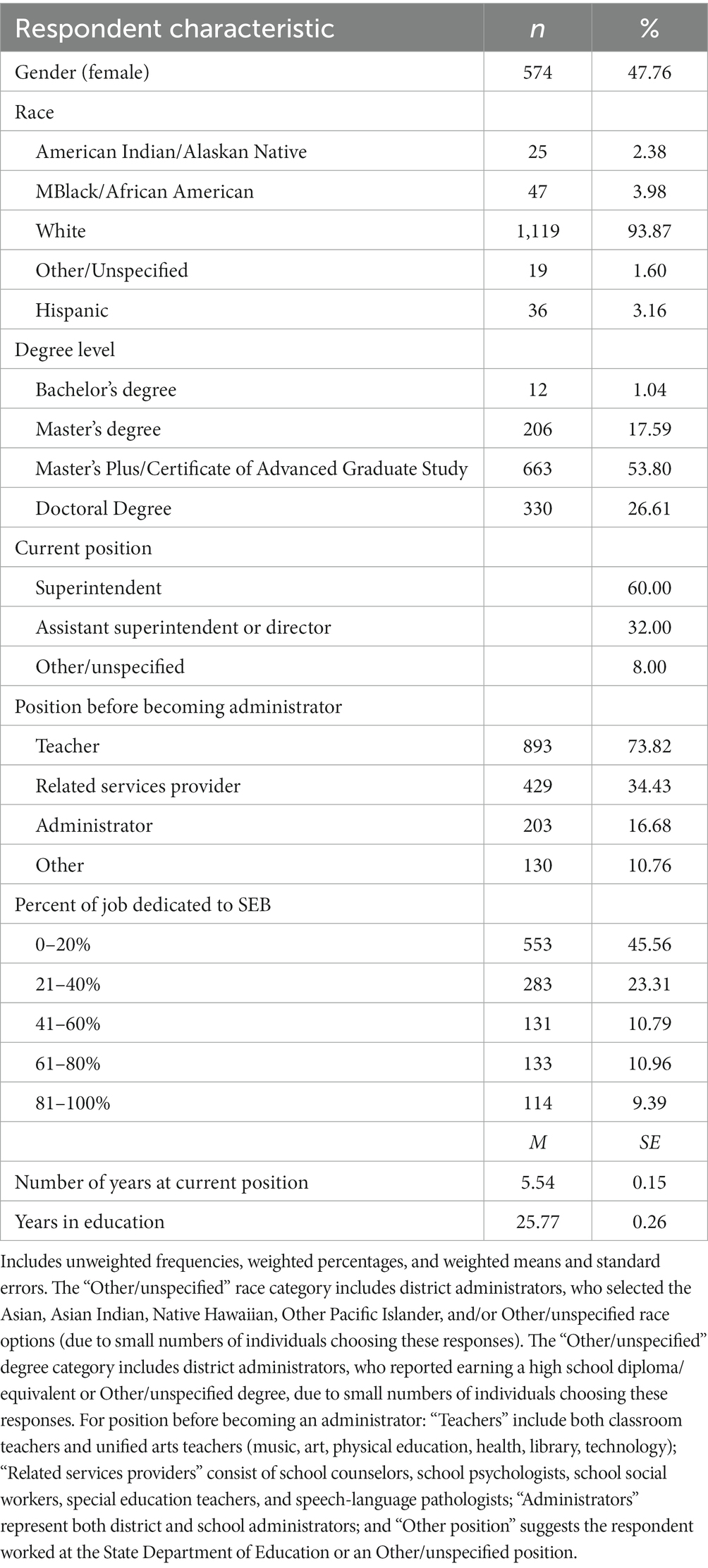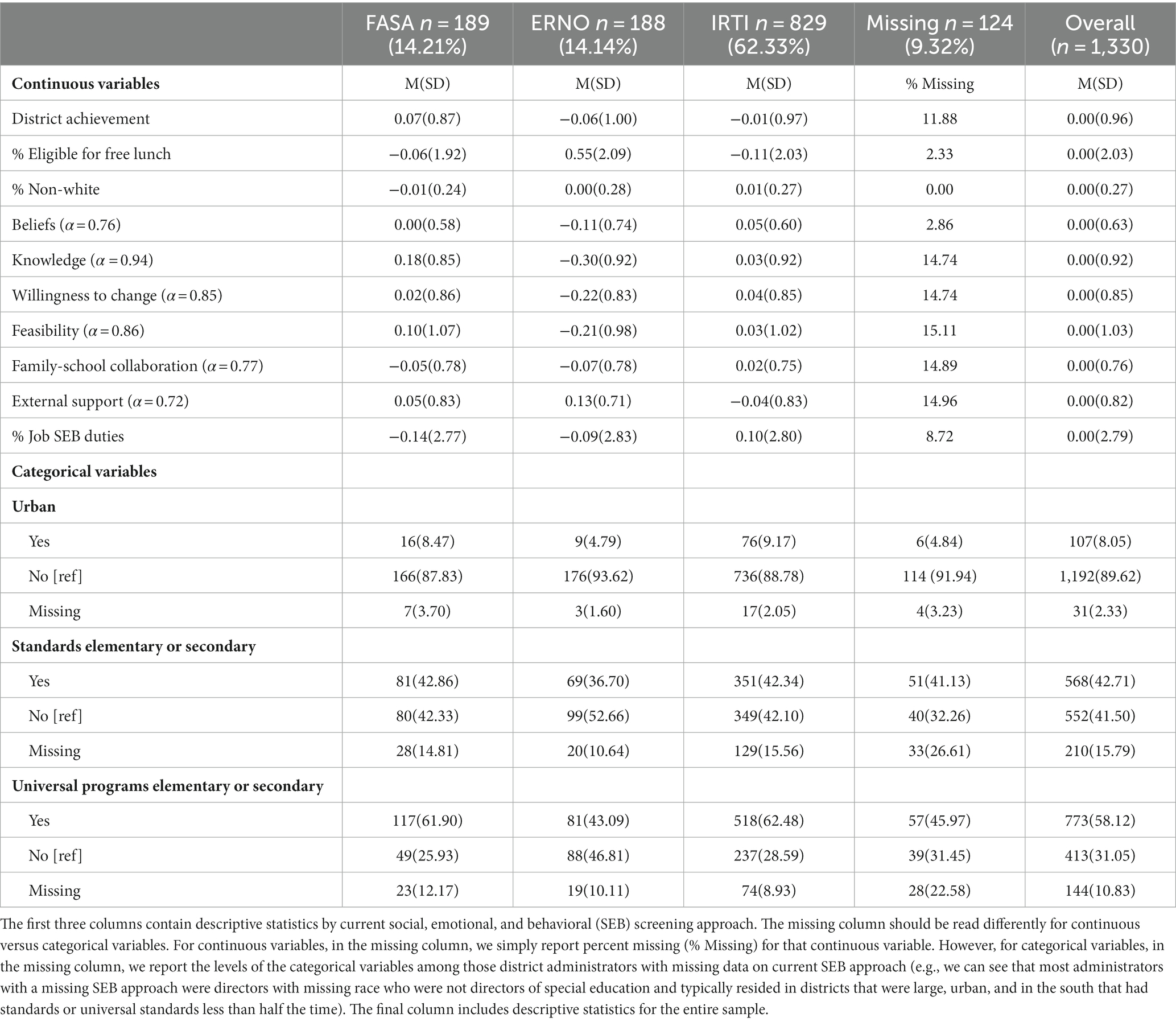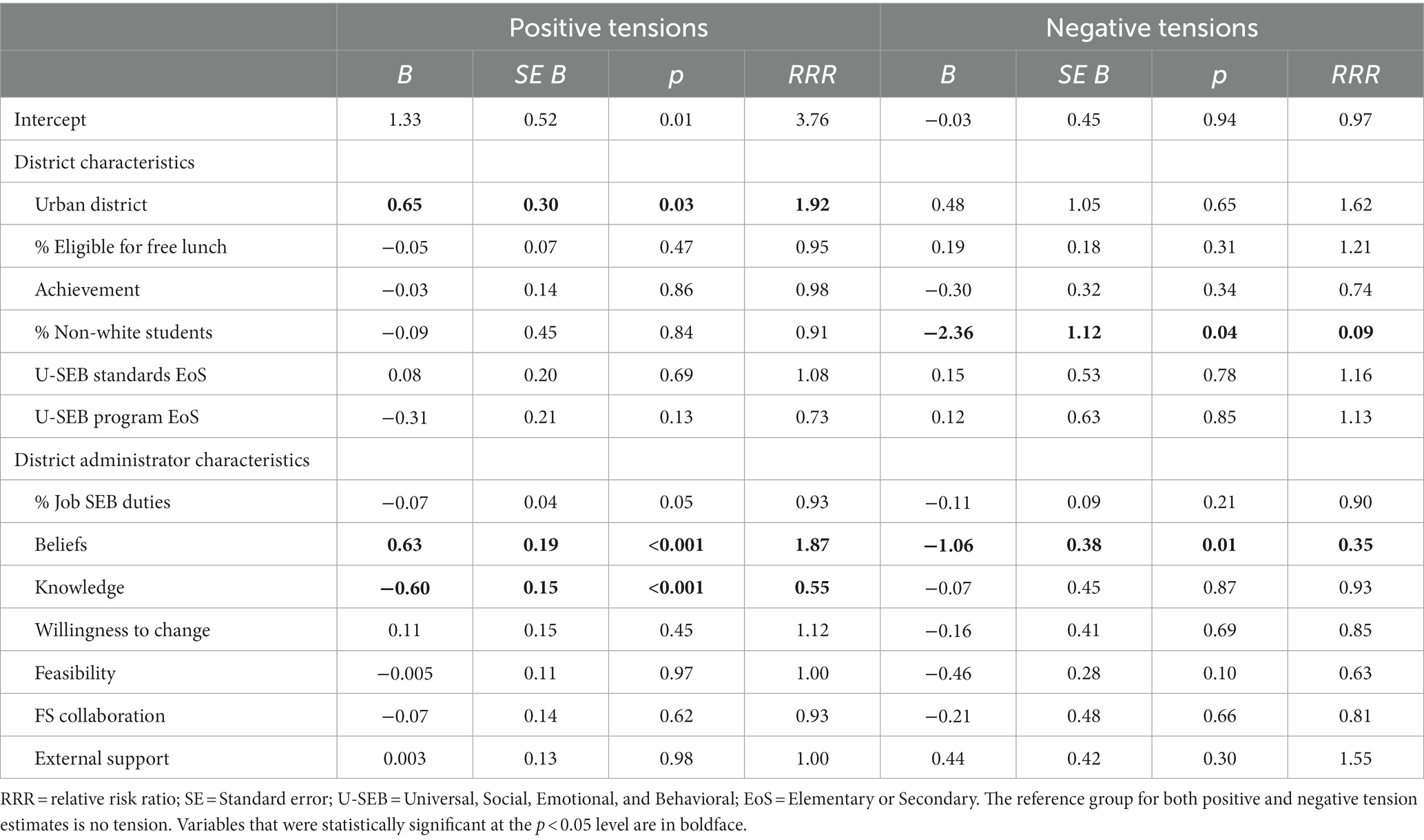District administrator perspectives of current and ideal approaches to identifying and supporting student social, emotional, and behavioral needs
- 1Department of Educational Psychology, University of Connecticut, Storrs, CT, United States
- 2Center for Integrative Developmental Science, Cornell University, Ithaca, NY, United States
- 3Department of Applied Psychology, Northeastern University, Boston, MA, United States
- 4Department of Public Policy, University of Connecticut, Storrs, CT, United States
Introduction: Leadership support has been identified as a key facilitator to successful implementation of school-based initiatives. School leadership contributions to student academic success and school reform have been documented, but less work has focused on the effects of leadership on school mental health initiatives such as social, emotional, and behavioral (SEB) screening. Few studies have investigated administrator knowledge and support for SEB screening or compared their current and ideal approaches to SEB screening, both of which are important to informing directions for implementation supports.
Methods: Using a nationally representative sample of U.S. public school districts, we investigated tensions between school district administrators’ (n = 1,330) current and ideal approaches to SEB screening within the current study. We fit binomial and multinomial logistic regression models to determine predictors of positive, negative, or no tensions based on the administrators’ current approach to SEB screening, administrators’ beliefs about the role of schools in student SEB concerns, and district demographics.
Results: Nearly half of administrators (46.7%) reported using an approach to SEB screening that was not their ideal approach. Higher beliefs scores commonly predicted administrator desire for more proactive approaches, whereas district characteristics yielded varied results.
Discussion: Results call for targeted next steps, including implementation supports, funding, and knowledge building aligned with administrator and district characteristics.
1 Introduction
There is an urgent need for effective identification and provision of youth social, emotional, and behavioral (SEB) supports. Nearly 10% of U.S. adolescents reported attempting suicide in 2021 and 57% of girls reported experiencing persistent feelings of sadness or hopelessness (Center for Disease Control and Prevention, 2023). Rates of mental health challenges increased across all adolescent demographic groups between 2011 and 2021; however, rises were most concerning for Black, Hispanic, multiracial, and LGBTQ+ students (Center for Disease Control and Prevention, 2023). School administrators report seeing the effects of these mental health challenges in schools, with 70% reporting increased student self-referral for services and 76% reporting delayed social emotional development in their students (U.S. Department of Education, 2022).
Schools are the most common site for students to receive SEB supports (e.g., mental health services; Duong et al., 2021) and reduce barriers related to cost, transportation, and scheduling. Yet, it is estimated that only 20–45% of youth with clinically significant symptoms receive services (Costello et al., 2014). One possible explanation for this gap is that schools have traditionally relied on teacher referral systems that do not always capture students in need of support. For example, teachers are more likely to refer students with externalizing disorders (e.g., ADHD) than those with internalizing disorders (e.g., anxiety, depression; Bradshaw et al., 2008). Thus, schools need improved systems for proactively and effectively identifying students in need of support.
One promising solution to this problem is universal screening, whereby all students—regardless of any known risk factors—are assessed to identify those in need of support (Hoover et al., 2015). Federal legislation, including the Every Student Succeeds Act (Every Student Succeeds Act, 2015), allows schools to utilize federal funding to provide students with academic and SEB supports, including the implementation of universal screening systems. A wide range of key groups (e.g., parents, teachers, school administrators) support the use of universal screening (Briesch et al., 2020; Moore et al., 2022). Benefits include systematic, equitable, and efficient identification of students in need of support. Proactive, universal SEB screening also aims to identify concerns before they become severe or have long-term effects (e.g., health, academic achievement). As untreated SEB concerns tend to become more debilitating and resistant to intervention over time (Bradley et al., 2008), early identification and intervention can also be cost-effective by preventing need for long-term or more intensive care (Humphrey and Wigelsworth, 2016).
Although a proactive and preventative model is considered best practice (e.g., Lane et al., 2010; National Center for School Mental Health, 2021), surveys have found that only 10–15% of school districts conduct universal SEB screening (Bruhn et al., 2014; Briesch et al., 2021). These low percentages raise the question of what approaches schools instead use to identify and support student SEB concerns. Dineen et al. (2021) sought to answer this question by analyzing data from a nationally-representative survey of district administrators in the 2015–2016 school year. The most common approach reported (54.7% of districts) was internal referral, in which school staff nominate students exhibiting SEB concerns to an internal support team and this team establishes an intervention plan. Roughly one in eight districts (12.1%) used external referral, where they referred students exhibiting SEB concerns to an outside agency. Just over 10% of districts used teacher intervention, in which teachers were encouraged to independently develop and implement an intervention plan in the classroom. A similar percentage (9.8%) of districts utilized targeted screening, in which a familiar adult (e.g., teacher) completed a screening measure only for those students that they perceived to be exhibiting SEB concerns. Least common among this sample of respondents was universal screening, with the percentage of district administrators reporting this approach falling even below prior survey estimates (i.e., 5.5% of districts).
Based on earlier studies conducted in community and convenience samples (Romer and McIntosh, 2005; Bruhn et al., 2014), these rates of universal SEB screening have shown little change in the past 15 years. Given that rates have remained stagnant despite repeated calls made to implement SEB screening in school settings (e.g., New Freedom Commission on Mental Health, 2003; U.S. Department of Education, Office of Special Education and Rehabilitative Services, 2021), researchers have sought to identify those factors that may help to explain this observed gap. One possible explanation is that there is little state or federal guidance regarding universal SEB screening. In a review of state-level guidance regarding school-based SEB screening, Briesch et al. (2017) found that only one state mandated universal SEB screening. Although an additional six states explicitly recommended universal SEB screening, recommendations lacked specificity in how districts were expected to implement such practices (Briesch et al., 2017). Additionally, research suggests that additional barriers to universal SEB screening include lack of awareness of SEB screeners (i.e., not knowing measures existed), funding (i.e., not being able to afford measures), and access (i.e., not being able to locate or obtain measures; Bruhn et al., 2014). Thus, a range of contextual variables may be important to understanding district decisions regarding universal SEB screening.
In addition to these contextual variables, decisions about universal SEB screening are made at the school or district level (Dineen et al., 2021) and thus, school leaders may be important levers of change in increasing uptake of universal SEB screening. For example, the success of any educational reform hinges on local school leaders’ perceptions of its importance and their willingness to invest resources (e.g., time, personnel, money) to facilitate implementation (Leithwood, 2010). Across studies and models of implementation, leadership and administrative support have been identified as key facilitators of successful implementation (Rogers, 1995; Domitrovich et al., 2008; Wandersman et al., 2008; Aarons et al., 2011). Through their studies of multi-tiered systems of support (MTSS) and response to intervention (RTI) implementation, for example, O’Connor and Freeman (2012) and Freeman et al. (2015) identified three key ways that district administrators can facilitate or impede implementation of educational reforms. First, district administrators’ leadership skills, including their abilities to respond to technical (e.g., time constraints) and adaptive (e.g., staff resistance) challenges to implementation, are key to implementation of educational reforms. Second, the degree to which district administrators create and support organizational structures (e.g., systems and structures for collecting, analyzing, and interpreting data; creating and maintaining relationships with community partners who can support delivery of tiered mental health supports) influences the success or failure of implementation. Finally, implementation is influenced by district administrators’ degree of knowledge and competency relative to the educational reform. This is demonstrated through their abilities to identify implementation leaders, ensure necessary professional learning, and monitor fidelity of implementation.
Regarding this final point, administrators’ beliefs and knowledge about SEB screening may therefore be important characteristics affecting decisions about universal SEB screening. For example, if administrators do not believe student SEB problems are a concern or are within the purview of school to assess, they are unlikely to adopt universal SEB screening procedures. In addition, if they do not believe that universal screening will help them to address SEB concerns, they are unlikely to invest resources in this way.
In summary, students are experiencing alarming rates of SEB concerns and schools are attempting to provide associated supports. However, schools struggle to accurately identify all students in need of support, which can lead to negative consequences for students, families, and communities. There is an urgent need for effective and efficient systems that identify students in need of SEB support. Universal SEB screening may be such a system as it systematically and effectively identifies students in need of support. Uptake of universal screening practices, however, has remained persistently low. Research is needed to inform the types of support across the educational ecosystem (e.g., individual, district, policy levels) that might improve use of universal SEB screening. District administrators can therefore serve as either critical champions or roadblocks for large scale changes such as universal SEB screening in schools (Torres et al., 2018).
2 Study aim
To date, there has been limited investigation into the role of district administrators in implementing SEB screening or supports. As universal SEB screening is considered best practice (e.g., Lane et al., 2010; National Center for School Mental Health, 2021), and decisions are made at the school or district level (Dineen et al., 2021), understanding district administrators’ perceptions of their current approaches may offer insight into next steps and necessary supports to increase uptake of universal SEB screening in schools. The purpose of the present study was to survey a nationally representative sample of U.S. public school district administrators to understand whether discrepancies exist between the current practices used to identify and support students’ SEB needs in schools and those practices believed to be ideal. Understanding these perspectives may inform important next steps in increasing uptake of universal SEB screening. For example, if administrators desire more proactive approaches, systems level support (e.g., funding, implementation supports) to guide implementation may be necessary. On the contrary, if administrators are satisfied with internal or external referral processes, further investigation into the perceived feasibility of universal screening may be warranted. Finally, satisfaction with current internal or external referral processes, or a desire to implement one of these approaches, may suggest a need to develop administrator knowledge and attitudes about identification and access to SEB services among students (e.g., Costello et al., 2014) and the short- and long-term impacts of unaddressed SEB concerns on student success. In addition, we were interested in identifying variables that may explain current versus ideal SEB screening practices. Research questions were as follows: Do differences exist between district administrators’ reported current and ideal approaches to identifying and supporting students’ SEB needs? If so, what are the possible explanatory variables (personal demographics and beliefs, district demographics, usability factors) for these differences?
3 Method
3.1 Participants and data sources
The sample for this study included district administrators (N = 1,330) from a nationally representative sample of public-school districts who participated in a 2015–16 survey that assessed the participants’ understanding, perceptions of, and approaches used to identify and support student SEB needs. The survey asked district administrators about their current approaches to identifying and supporting SEB needs as well as what they believed was the most ideal approach to identify and support student SEB needs. The sampling frame for the nationally representative survey included public elementary and secondary school districts in the United States and was developed using the 2013–14 Common Core of Data Local Education Agency Universe Survey. After contacting a total of 12,315 district administrators, 1,330 total responses were obtained (response rate: 10.8%; demographics in Table 1). Most survey participants (60%) held the title of district superintendent. All others held district-level leadership roles (e.g., assistant superintendent, director of pupil services). The vast majority (96%) worked in their position full time. Throughout the remainder of the article, we refer to participants as district administrators. Weights were applied to adjust for nonresponse across census region, urbanicity, and district size to establish a nationally representative dataset of U.S. public school districts. Additional details on the survey design can be found in Marcy et al. (2018).
3.1.1 School district characteristics
Table 2 contains the descriptive results. Most district administrators were from non-urban (89.62%) districts. Approximately half of districts had both standards (42.71%) and universal programs (58.12%) for SEB learning at the elementary or secondary level (i.e., indicating what SEB competencies students should be able to demonstrate at different grade levels).
3.2 Measures/variables
3.2.1 Current and ideal SEB approach
District administrators were asked to respond to a question about their current SEB approach and a question about their ideal SEB approach (see Table 3). Response options were screening for all, familiar adult nomination, internal referral, teacher intervention, external referral. District administrators were guided with explanations of the approaches (see Marcy et al., 2018). Descriptions are provided in Dineen et al. (2021), with the options ranging from most proactive and preventive (e.g., screening for all: every student is included in screening) to least proactive and preventive (e.g., external referral: referring for outside assistance). Respondents additionally had the opportunity to specify a different approach (i.e., Other). The Other category was later coded into “do not know,” “another approach,” “prefer not to answer,” or “no approach.” Consistent with Dineen et al. (2021), responses were then collapsed into three groups to capture (a) standard approaches applied to all students in a population (FASA = familiar adult nomination + screening for all), (b) internally managed identification methods (IRTI = internal referral + teacher intervention), and (c) externally managed or absent processes (ERNO = external referral + no approach). Note that “No Approach” included 35 of the 94 responses included in the Other category.
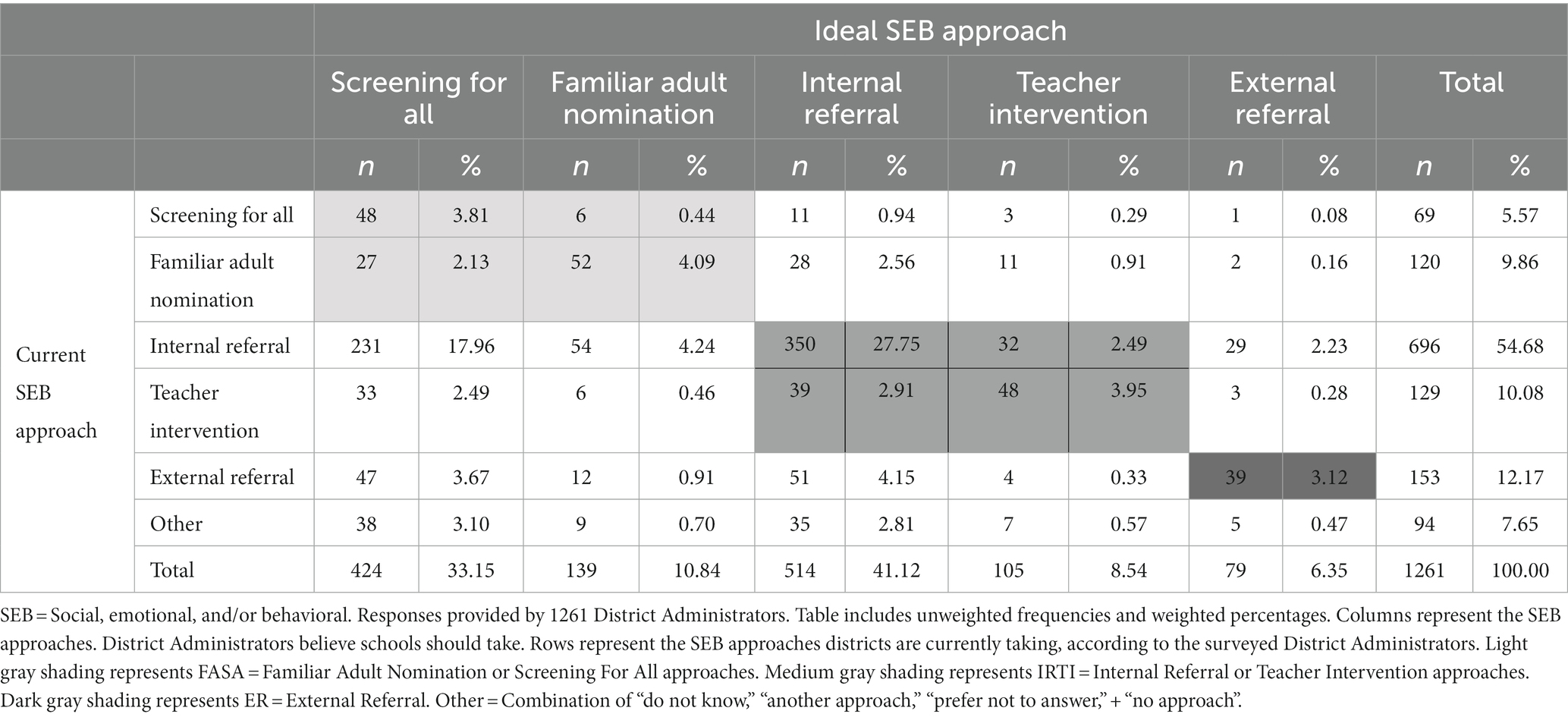
Table 3. District administrator perceptions: ideal and current approaches to social, emotional, and behavioral screening.
3.2.2 Covariates
3.2.2.1 District administrator characteristics
District administrators were asked what percentage of their current job responsibilities involved student SEB well-being. We named this covariate “% Job SEB duties” and centered it. In addition, we included several scale scores as covariates that capture district administrators’ beliefs and understanding of SEB screening practices. First, we included a Beliefs scale that is a measure of district administrator’s personal beliefs about student SEB problems. The Beliefs scale was constructed by using scale scores across three items: (1) Student social, emotional, and behavioral problems are a concern, (2) Addressing student social, emotional, and behavioral problems should be a priority, and (3) Including social, emotional, and behavioral screening procedures is an important step toward addressing these problems at school. These items utilized a 5-point Likert scale (1 = “do not agree at all,” 5 = “completely agree”). We also included the scale scores for five scales from the Usage Rating Profile for Supporting Students’ Behavioral Needs (URP-NEEDS: Chafouleas et al., 2018). The URP-NEEDS was created to evaluate perceptions of usability surrounding school-based approaches to SEB risk identification and support. The five URP-NEEDS scales that we included as covariates were: Willingness to Change (i.e., the degree to which school personnel are open and willing to try new strategies and procedures), Knowledge (i.e., the degree to which school personnel are confident in their ability to carry out the SEB approach), Feasibility (i.e., the degree to which school personnel believe the total time required to carry out the SEB approach is manageable), Family-School Collaboration (i.e., the degree to which collaboration and communication with families is needed to support usage of the SEB approach), and External Support (i.e., the degree to which connections to community agencies are necessary to implement the SEB approach). Further information on the URP-NEEDS scales can be found in Briesch et al. (2020). Each of the six scales were centered. Cronbach’s alphas for scores on each of the 6 subscales exceeded 0.70 (see Table 2).
3.2.2.2 District characteristics
We also included several covariates that describe district characteristics. We included sociodemographic district covariates such whether the district was categorized as urban (yes or no), the average district achievement in third grade math and English language arts (centered), the percentage of students eligible for free lunch (centered), and the percentage of non-white students in the district (centered) (see Table 3). We also included two categorical variables that indicated whether the district had universal SEB standards at the elementary or secondary level (i.e., indicating what SEB competencies students should be able to demonstrate at different grade levels) and whether the district had a universal SEB curriculum or program at the elementary or secondary level (i.e., Positive Behavioral Interventions and Supports; social–emotional learning curriculum).
3.3 Analysis plan: predicting tensions
The focus of this paper is on tensions between district level administrators’ current and ideal approaches to identifying and supporting students’ SEB needs. Dummy variables were therefore first created to identify if each administrator reported positive tensions (i.e., a desire to move to a more comprehensive SEB approach), negative tensions (i.e., a desire to move to a less comprehensive SEB approach), or no tension (i.e., current approach is aligned with ideal approach). For the purposes of this study, we considered the most proactive and preventive approach to be use of screening (i.e., screening for all or familiar adult nomination), as within these approaches schools proactively seek to identify and support student needs using internal resources. Somewhat less proactive and preventive were the use of internal referral or teacher intervention, as both approaches were considered more reactive (i.e., wait until problems emerge to assess and intervene) but did aim to provide needed supports internally. The least proactive and preventive approaches were external referral and no approach, as such approaches either sought to refer concerns outside of the school building or did not actively address concerns.
Once the dummy variables were created, we conducted descriptive analyses to examine the patterns of positive, negative, and no tensions. For some groups, positive or negative tensions were not possible. For instance, district administrators whose current SEB approach to screening was FASA could only have negative tensions (i.e., the ideal approach they selected had to be less proactive and preventive) whereas district administrators whose current SEB approach to screening was ERNO could only have positive tensions (i.e., the ideal approach they selected had to be more proactive and preventive). However, district administrators whose current SEB approach to screening was IRTI could have either have a positive or negative tension. Therefore, we stratified our sample by whether the district administrators’ current approach to SEB screening was FASA, ERNO, or IRTI.
We fit two binary logistic regression models and one multinomial logistic regression model. The first model predicted positive tension versus no tension. For this model, we only included district administrators reporting an ERNO approach. The second model predicted negative tension versus no tension. We only included district administrators reporting an FASA approach in this model. Finally, the third model was a multinomial logistic regression with a nominal categorical outcome consisting of three categories: negative tension, no tension (reference group), and positive tension. For this model, we only included district administrators reporting an IRTI approach. For each analysis, we included several district administrator characteristics and district characteristics as covariates (see above for descriptions). All analyses were conducted in Stata 17 (StataCorp, 2021). All analyses were conducted using the sampling weights that were developed for the study to account for district non-response across census region, urbanicity (five categories), and district size (see Marcy et al., 2018). We report the odds ratio for the two binary logistic regression models, that is, the ratio of the probability of a positive (negative) tension and the probability of no tension with respect to the predictor variable in question. An odds ratio greater than one indicates that the odds of a positive (negative) tension are greater than no tension whereas an odds ratio less than one indicates that the odds of no tension are greater. For the multinomial regression model, we report the relative risk ratio (RRR) which is a coefficient indicating how the likelihood of a positive (negative) tension compared to the likelihood of the outcome falling in the referent group (i.e., no tension) changes with respect to the variable in question. An RRR greater than one indicates that the likelihood of a positive (negative) tension relative to the likelihood of the referent group (i.e., no tension) increases with respect to the predictor variable in question. In other words, a positive (negative) tension is more likely than no tension. An RRR less than one indicates that the likelihood of positive (negative) tension relative to the likelihood of the referent group (i.e., no tension) decreases with respect to the predictor variable in question.
4 Results
4.1 Descriptive analyses
Table 3 presents district administrators’ responses to the questions regarding current and ideal SEB approaches. The gray diagonals indicate no tension: the current approach and the ideal approach match. Negative tensions appear above the diagonal whereas positive tensions appear below the diagonal. Table 4 contains the simplified table of tensions regarding current SEB approach versus ideal SEB approach, which collapses into three groups representing most to least proactive and preventive: FASA (familiar adult nomination + screening for all), IRTI (internal referral + teacher intervention) and ERNO (external referral + no approach).

Table 4. District administrator perceptions: ideal and current approaches to social, emotional, and behavioral screening (using three analytic categories).
The majority of district administrators (825, 68.1%) reported using IRTI approaches to SEB screening. Of those using IRTI, the majority of administrators (469/825, 56.8%) felt that their current approach was the ideal approach. When current IRTI administrators identified a tension between their current and ideal approaches (356/825, 43.2%), they were far more likely to identify FASA as the ideal approach (324/356, 91%) than to identify ER as the ideal approach (32/356, 9.0%). This means that district administrators using IRTI were over 10 times (324/32 = 10.125) more likely to exhibit positive tensions than to exhibit negative tensions.
In districts using ERNO, it was only possible to exhibit positive tensions or no tensions. Over 78% of the 188 district administrators using ERNO exhibited positive tensions (148/188, 78.8%) whereas 21.2% (40/188, 21.3%) of ERNO district administrators indicated no tensions (i.e., that the external referral process was ideal). This means that district administrators in ERNO districts were 3.7 times more likely to exhibit positive tensions than no tensions (148/40).
In districts using FASA, it was only possible to exhibit negative tensions or no tensions. Almost 30% of the FASA districts (56/189, 29.6%) exhibited negative tensions, and over 70% of the FASA districts exhibited no tension (133/189, 70.4%). This means that administrators in FASA districts were 2.4 times more likely to exhibit no tensions than to exhibit negative tensions (133/56).
Several variables varied by district administrators’ current approach to SEB screening. For example, ERNO district administrators were on average more likely to have a greater percentage of students eligible for free lunch (M = 43%) than either FASA (M = 37%) or IRTI (M = 36.5%) district administrators. Similarly, ERNO district administrators were on average more likely to have lower beliefs, knowledge, willingness to change, and feasibility scores than FASA and IRTI administrators. For example, ERNO district administrators had lower knowledge scores (M = 3.51, SD = 0.92) than FASA (M = 4.00, SD = 0.85) and IRTI (M = 3.84, SD = 0.92) administrators. There were also variables that did not vary by district administrators’ current approach to SEB screening. For example, on average, the percent of non-white students in a district did not vary much by current approach to SEB screening.
4.2 Predictors of tensions
4.2.1 Positive tensions for ERNO administrators
Table 5 contains the results for the positive tensions analysis. For administrators reporting use of an ERNO approach, there were two statistically significant predictors: the beliefs scale and the use of universal SEB programs at the elementary or secondary level. Holding other variables constant, the presence of universal SEB programs at the elementary or secondary level increased the likelihood that district administrators reporting an ENRO approach exhibited positive tensions. Higher belief scores also increased the likelihood that district administrators reporting an ENRO approach exhibited positive tensions. That is, as district administrators’ positive beliefs about addressing SEB issues in schools increased, they were more likely to view a more proactive and preventive approach to identifying and supporting students’ SEB needs as desirable. Figure 1 shows the relationship between beliefs and positive tensions in ERNO districts. For example, the probability of exhibiting tensions was 0.59 for ERNO districts without universal SEB programs whose beliefs scores were one standard deviation below the mean, but 0.80 for districts without universal SEB programs in place whose beliefs scores were one standard deviation above the mean. In ERNO districts, when beliefs scores were one standard deviation above the mean, the probability of endorsing positive tensions was 0.93 if districts had universal SEB programs in place, and 0.84 if they did not.
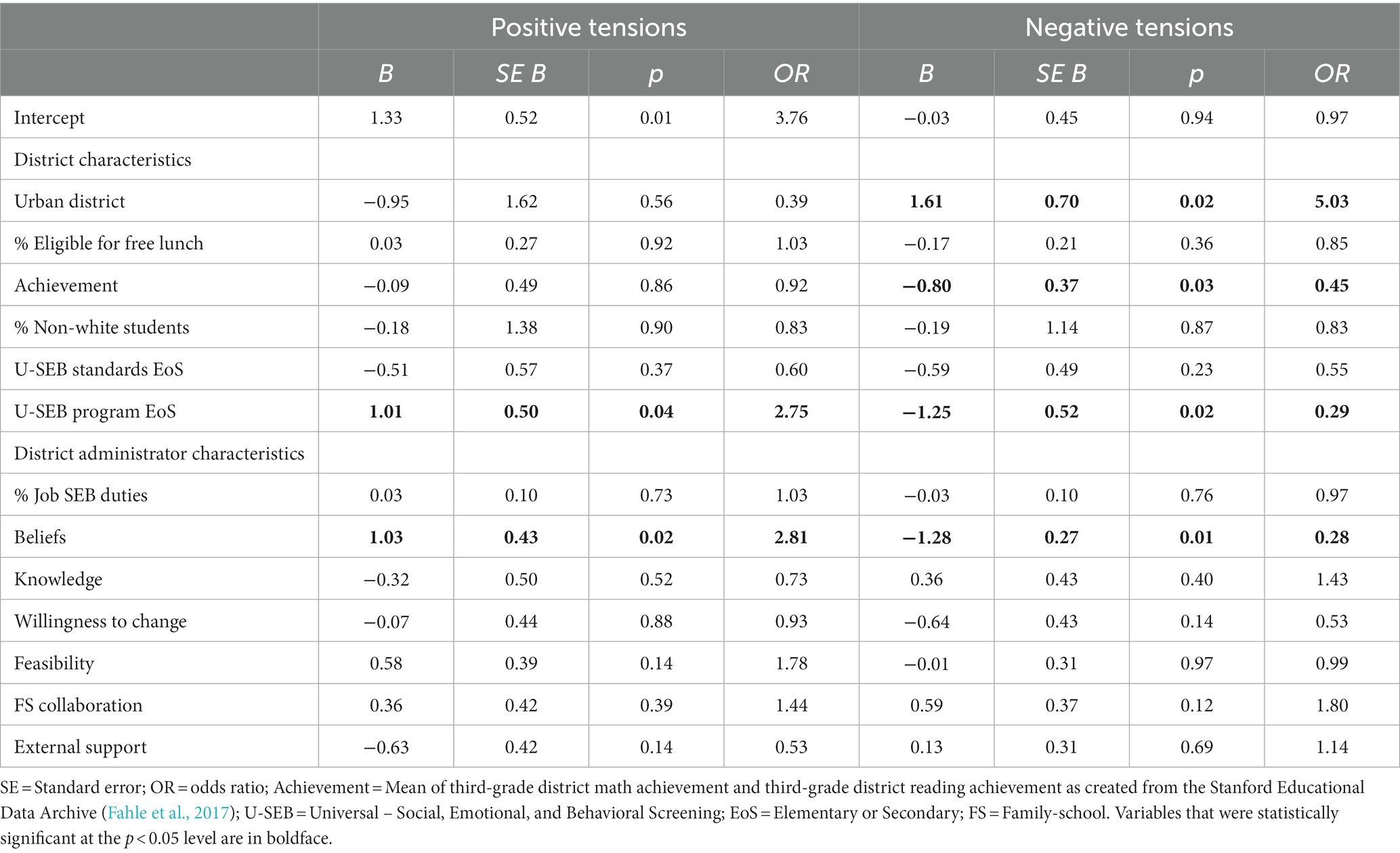
Table 5. Logistic regression results for positive tensions (ERNO, n = 115) and negative tensions (FASA, n = 125).
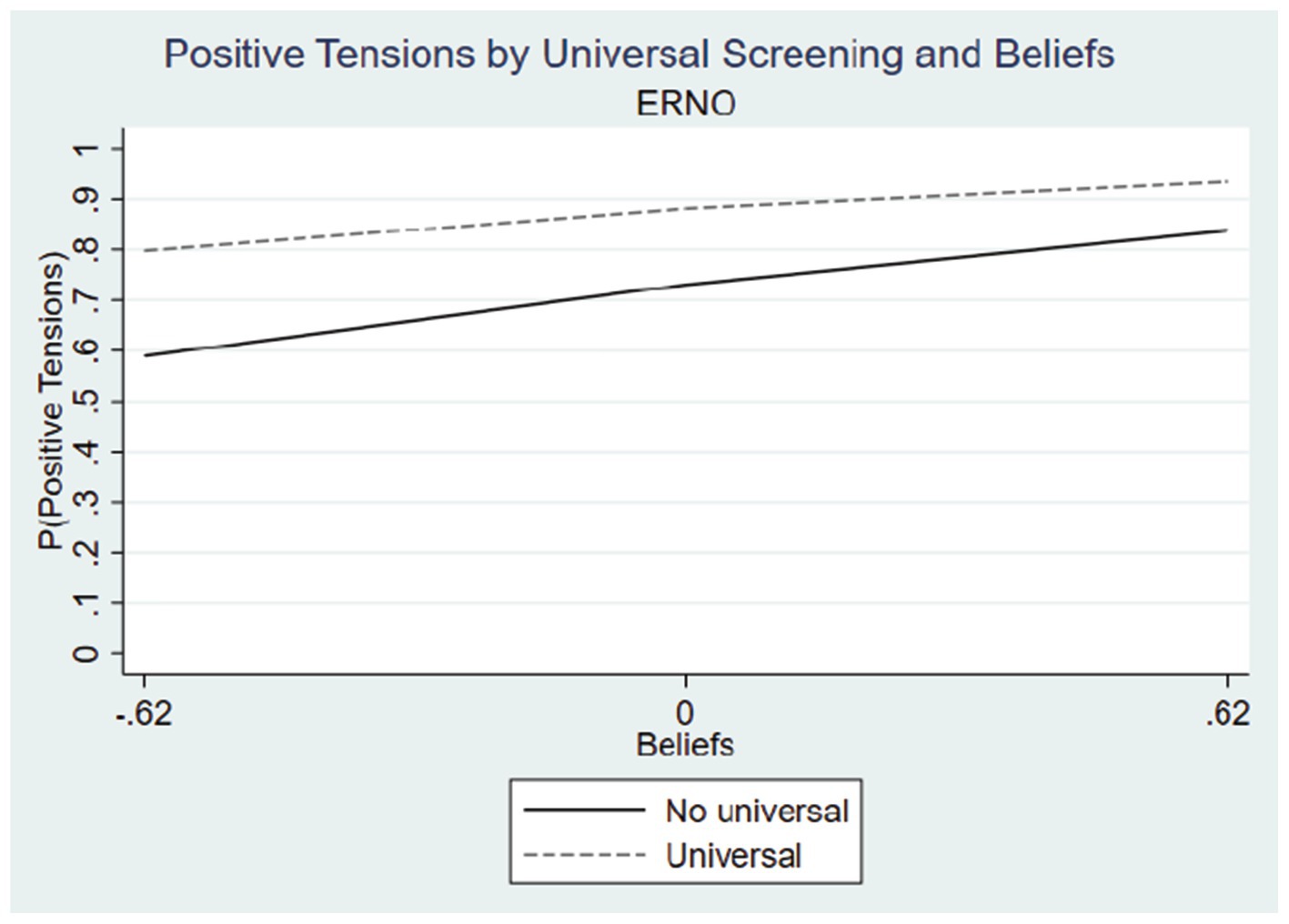
Figure 1. Probability of a positive tensions as a function beliefs about SEB concerns (ERNO, n = 115).
4.2.2 Negative tensions for FASA administrators
Table 5 also contains the results for the negative tensions analysis. For district administrators reporting a FASA approach, urbanicity, district achievement, universal SEB programs, and beliefs scores were statistically significant predictors of negative tensions. That is, holding other variables constant, having higher belief scores, universal SEB programs at either the elementary or secondary level, or higher achievement scores reduced the likelihood that district administrators reporting FASA approaches exhibited negative tensions. In addition, district administrators in urban FASA districts had a greater likelihood of exhibiting negative tensions. Figure 2 graphs the relationships among these variables.
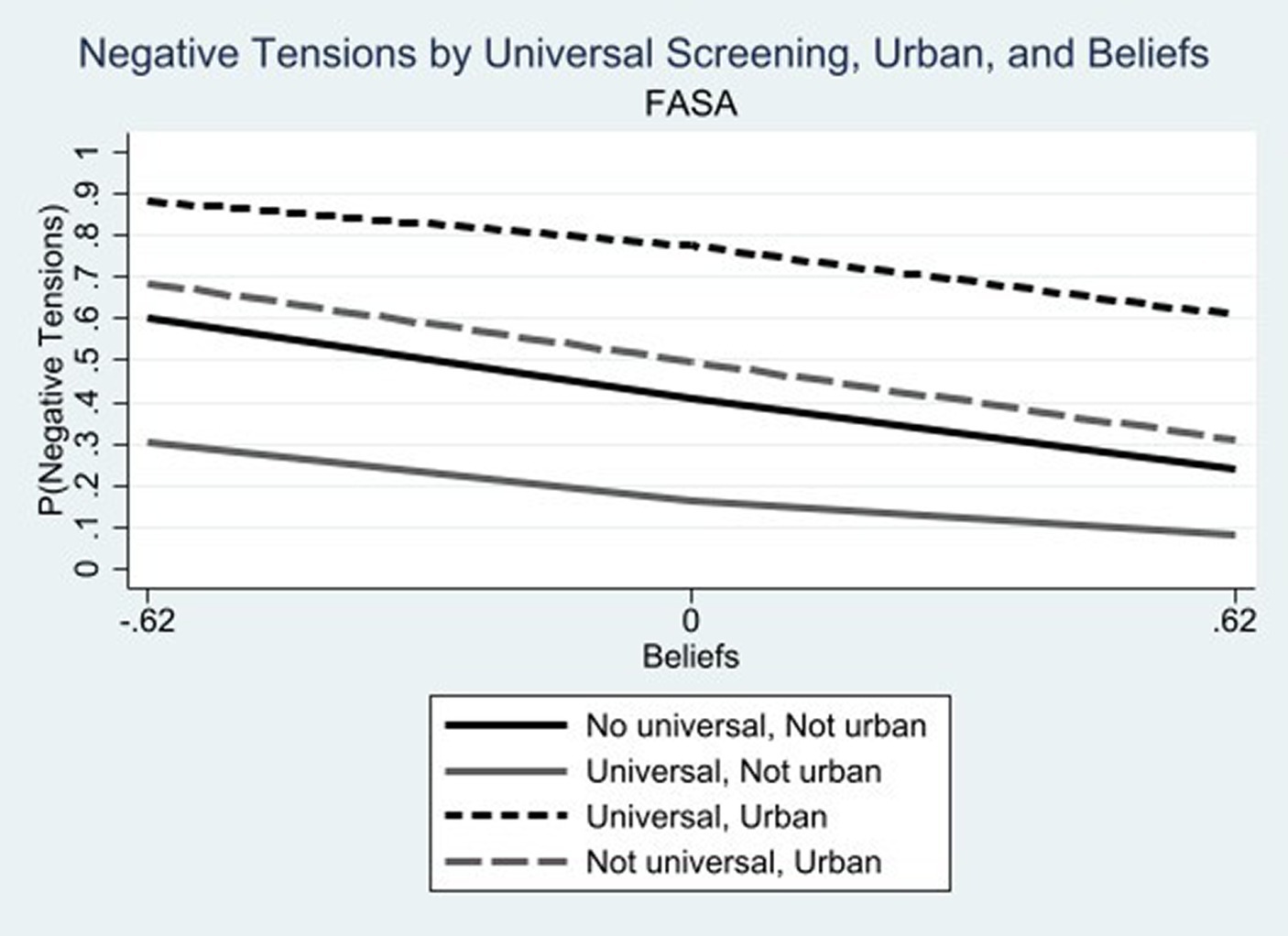
Figure 2. Probability of negative tensions as a function beliefs about SEB concerns and urbanicity (FASA, n = 125).
4.2.3 Positive or negative tensions for IRTI administrators
Table 6 contains the results for the positive or negative tensions analysis for district administrators who reported using an IRTI approach. Holding all other variables constant, urbanicity and higher belief scores increased the likelihood that district administrators reporting an IRTI approach exhibited positive tensions relative to those in the no tensions group. Higher knowledge scores, however, reduced the likelihood of exhibiting positive tensions. For district administrators reporting an IRTI approach, higher percentages of non-white students and higher belief scores reduced the likelihood of negative tensions, after controlling for other variables in the model. The relative risk ratios for the multinomial model are reported in Table 6. Figure 3 depicts the probability of exhibiting positive or negative tensions for administrators in IRTI districts as a function of their beliefs scores. As Figure 3 shows, when IRTI administrators’ beliefs scores were one standard deviation above the mean, the likelihood of exhibiting positive tensions or no tensions were the same. Generally, regardless of their beliefs, the probability of endorsing negative tensions was quite low.
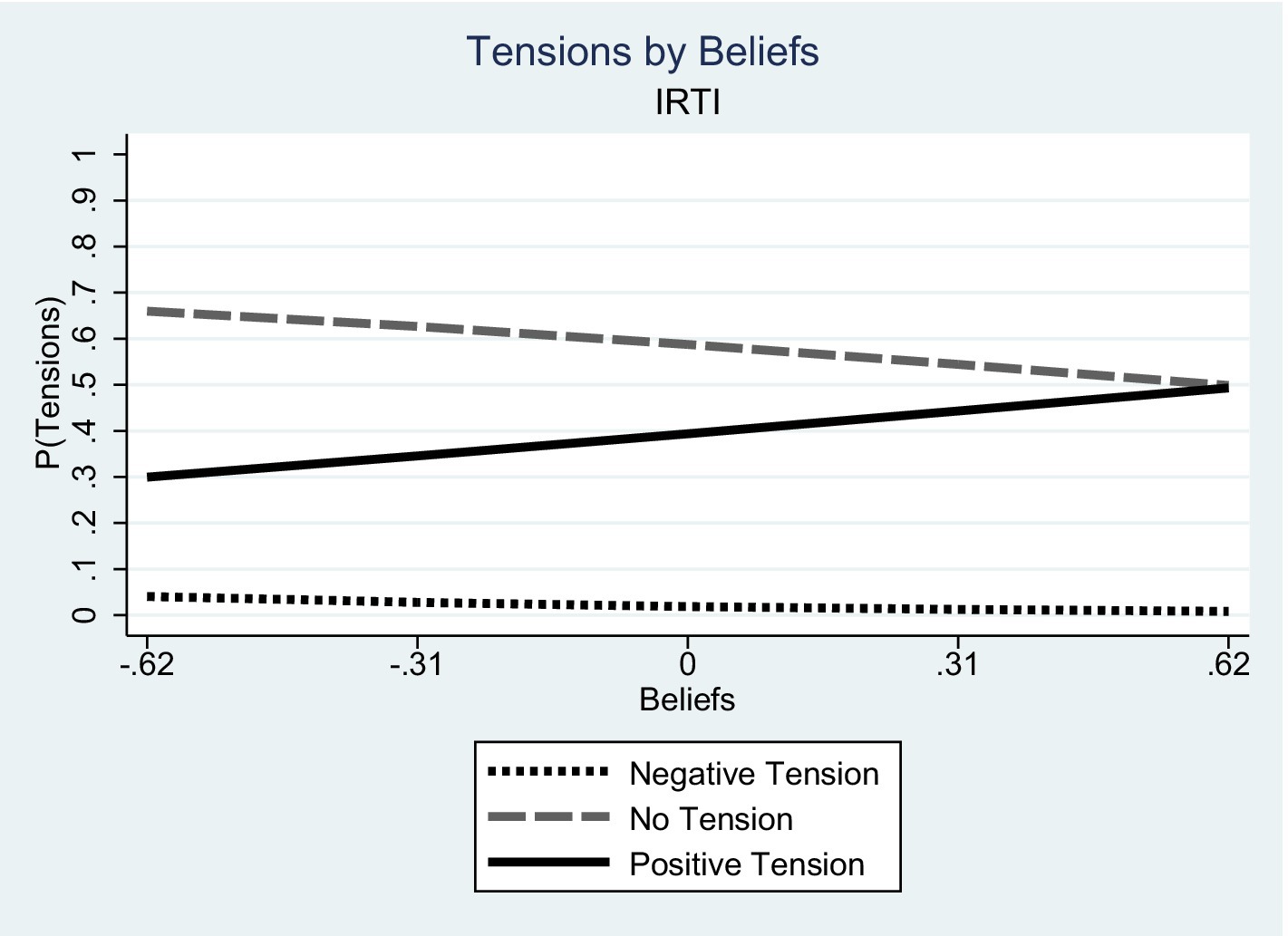
Figure 3. Probability of positive or negative tensions as a function of beliefs about SEB issues (IRTI, n = 576).
5 Discussion
The purpose of the present study was to explore whether tensions exist between district administrators’ perceptions of current and ideal approaches to supporting students’ SEB needs in a nationally representative sample of public school districts. We also investigated whether administrator or district characteristics predicted tensions or alignment between administrators’ ideal and current SEB approaches. Interestingly, nearly half of administrators (47%) reported using an approach to SEB screening that was not their ideal approach. Whereas the majority of administrators who reported using more proactive approaches (i.e., internal referral/teacher intervention, familiar adult nomination/screening for all) perceived their current approach as being the ideal approach, greater tensions were identified for those administrators reporting use of external referral or no approach. These results are discussed in greater detail next.
5.1 District administrators using external referral or no approach (ERNO)
Roughly 15% of administrators reported that their districts referred students to an outside agency or had no approach to identifying student SEB concerns. This group of administrators was also less likely to personally view student SEB problems as a concern in need of addressing in schools (i.e., beliefs score), as well as less likely to believe that school personnel (a) had the knowledge needed to carry out their SEB approach (i.e., knowledge score), (b) were willing to try new strategies and procedures (i.e., willingness to change score), and (c) believed the time needed to carry out their SEB approach was reasonable (i.e., feasibility score). Lack of administrator support has been identified as a barrier to the implementation of school-based SEB programs (e.g., Langley et al., 2010; McDaniel et al., 2017) and may suggest the need for administrator training aimed at understanding both the SEB needs of their students and the benefits of adopting more proactive approaches to addressing these needs. Results suggest that such professional development may also be beneficial for school staff who may be unaware of the procedures and benefits of more proactive approaches.
Interestingly, nearly 80% of these administrators desired a more proactive approach. Higher belief scores regarding the role of schools in addressing SEB concerns and the presence of at least some universal SEB programs in the district increased the likelihood that district administrators reporting an ENRO approach desired a more proactive approach. This is not surprising as the use of universal SEB programs in some schools and stronger beliefs scores suggest an openness to proactive approaches to supporting students’ needs. These findings suggest, however, that these districts and administrators might benefit from more tangible systems-level supports (e.g., policy, funding) to help them to implement more proactive and comprehensive approaches to SEB screening.
5.2 District administrators using internal referral or teacher intervention (IRTI)
Of the more than two-thirds (68%) of district administrators who reported using an internal referral team or teacher-led interventions to identify and support student SEB concerns, slightly more than half felt that this was the ideal approach as well. Those feeling that IRTI was not the ideal approach were much more likely to desire a more proactive approach (i.e., screening for all or familiar adult nomination) than a more reactive approach (i.e., external referral or no approach). District urbanicity and higher district administrator beliefs scores increased the likelihood that these administrators desired a more proactive and preventive approach. For these administrators, these findings suggest that efforts should focus on building capacity for implementation (e.g., training, resources) as opposed to administrator buy-in. Higher knowledge scores (i.e., feeling confident in their ability to carry out the SEB approach) reduced the likelihood that administrators desired a more proactive approach. It may be that these district administrators felt self-efficacious with their current system, and therefore did not desire a more proactive approach. Working in districts with a higher percentage of non-white students or having stronger beliefs about the role of schools in addressing SEB concerns reduced the likelihood that district administrators reporting an IRTI approach desired a more reactive approach.
5.3 District administrators using familiar adult nomination or screening for all (FASA)
Finally, although only 15% of district administrators reported using familiar adult nomination or screening for all in their district, the vast majority (70%) reported that this was also their ideal SEB approach. This aligns with prior findings that administrators are satisfied with the usability of these approaches (Dineen et al., 2021).
Of note, district urbanicity increased the likelihood that district administrators reporting a FASA approach desired a more reactive approach. This reflects a shift from results among IRTI district administrators, when urbanicity was a significant predictor of desiring a more proactive approach. Perhaps those working in urban FASA districts are overwhelmed by the resources required to screen and provide subsequent supports to students. Systems-level supports (e.g., funding, implementation support) may be beneficial. District administrators working in urban FASA districts may also benefit from collaboration with FASA districts of a similar size to brainstorm systems and structures that support effective implementation.
Finally, stronger district administrator beliefs about addressing SEB concerns in schools, higher levels of district achievement, and the presence of universal SEB programs reduced the likelihood that district administrators desired a more reactive approach. The finding regarding administrator beliefs is not surprising and aligns with findings in ERNO and IRTI districts as well; the likelihood of desiring a more reactive approach to SEB screening was reduced for administrators with more positive beliefs about the roles of schools in addressing SEB concerns. Concerning district characteristics, those administrators in districts with universal SEB programs in place may be more likely to see the value of collecting SEB screening data. That is, in addition to using screening data to identify individual students in need of supplemental intervention, school- or grade-wide data can be used to formally assess the effectiveness of the universal SEB supports that are in place.
5.4 Limitations and directions for future research
Although results of this study contribute to our understanding of school districts’ approaches to identifying and supporting students’ SEB needs, limitations of this study should be noted. First, due to the small number of respondents reporting particular SEB approaches, we chose to collapse two distinct approaches into one category (i.e., familiar adult nomination and screening for all = FASA). It is possible that these broader groupings may obscure some of the nuances that existed within the narrower categories, or that results from some analyses may change with availability of larger samples. For example, within the category of IRTI, only 10% of respondents indicated that teachers in their school independently identified and implemented interventions to address student SEB concerns. Given the absence of a central support system (i.e., student support team), these respondents may have differed either in terms of personal beliefs or district demographics. Second, analyses were based on two closed-response questions that asked respondents about current and ideal SEB approaches. Although we defined tensions as a discrepancy between current and ideal approaches, we did not collect qualitative data that would allow administrators to (a) speak to whether they felt such tensions and (b) explain those tensions, if applicable. Future researchers are encouraged to include mixed methods approaches in their data collection as qualitative data may provide more explicit directions for developing, delivering, and evaluating supports to facilitate district administrator decisions and mitigate tensions about SEB approaches. Related, it may be useful for future research to further distinguish the critical features of a proactive and preventive approach to identification and support. Exploring the relative contribution, for example, of universal screening versus programs or standards could inform directions for targeting systems change. In addition, it is important to note that data were collected in 2015–2016, which is before the COVID-19 pandemic. Therefore, results represent perceptions before the urgency of SEB health escalated. Future work may replicate the survey to evaluate changes over time.
5.5 Summary and implications
Low rates of school-based SEB screening have been reported in prior studies (Bruhn et al., 2014; Dineen et al., 2021); however, few empirical studies have sought to investigate the factors that may help to explain implementation (or lack thereof). The current study contributes to this literature by highlighting those characteristics of both school districts and school district leaders that may be associated with desire to change the status quo. Although unique differences in results were observed across the three groups (i.e., administrators in districts using external referral or no approach, administrators in districts using internal referral or teacher intervention, and administrators in districts using familiar adult nomination or screening for all), one commonality involved the role of administrator beliefs. That is, in all cases, district administrators’ more positive beliefs regarding the importance of addressing SEB needs in schools increased the likelihood that they would desire a more proactive and preventive approach to supporting students’ SEB needs. Such results align with prior work to identify district administrators as key determinants of educational change (e.g., O’Connor and Freeman, 2012; Freeman et al., 2015) by highlighting the role that administrators’ beliefs may play as one potentially important point of intervention for supporting change in school practices. Future research is needed to explore this finding further and to understand what information and conditions may be effective in modifying more resistant beliefs.
Data availability statement
The raw data supporting the conclusions of this article will be made available by the authors, without undue reservation, to any qualified researcher.
Ethics statement
The studies involving humans were approved by the University of Connecticut HSIRB. The studies were conducted in accordance with the local legislation and institutional requirements. The ethics committee/institutional review board waived the requirement of written informed consent for participation from the participants because informed consent was collected electronically.
Author contributions
SC: Writing – original draft, Writing – review & editing. DC: Writing – original draft, Writing – review & editing. JK: Writing – original draft, Writing – review & editing. AB: Writing – original draft, Writing – review & editing. DM: Writing – original draft, Writing – review & editing. JD: Writing – original draft.
Funding
The author(s) declare financial support was received for the research, authorship, and/or publication of this article. Preparation of this article was supported by funding provided by the Institute of Education Sciences, U.S. Department of Education (R305A140543: PI SC). Opinions expressed herein do not necessarily reflect the position of the U.S. Department of Education, and as such, endorsements should not be inferred.
Acknowledgments
Special thanks are provided to all survey participants for their time, and appreciation is extended to research team members (Emily Iovino, Austin Johnson, and Sarah Newton) for their assistance on the project.
Conflict of interest
The authors declare that the research was conducted in the absence of any commercial or financial relationships that could be construed as a potential conflict of interest.
Publisher’s note
All claims expressed in this article are solely those of the authors and do not necessarily represent those of their affiliated organizations, or those of the publisher, the editors and the reviewers. Any product that may be evaluated in this article, or claim that may be made by its manufacturer, is not guaranteed or endorsed by the publisher.
References
Aarons, G. A., Sommerfeld, D. H., and Willging, C. E. (2011). The soft underbelly of system change: the role of leadership and organizational climate in turnover during statewide behavioral health reform. Psychol. Serv. 8, 269–281. doi: 10.1037/a0026196
Bradley, R., Doolittle, J., and Bartolotta, R. (2008). Building on the data and adding to the discussion: the experiences and outcomes of students with emotional disturbance. J. Behav. Educ. 17, 4–23. doi: 10.1007/s10864-007-9058-6
Bradshaw, C. P., Buckley, J. A., and Ialongo, N. S. (2008). School-based service utilization among urban children with early onset educational and mental health problems: the squeaky wheel phenomenon. Sch. Psychol. Q. 23, 169–186. doi: 10.1037/1045-3830.23.2.169
Briesch, A. M., Chafouleas, S. M., and Chaffee, R. K. (2017). Analysis of state-level guidance regarding school-based, universal for social, emotional, and behavioral risk. Sch. Ment. Heal. 10, 147–162. doi: 10.1007/s12310-017-9232-5
Briesch, A. M., Chafouleas, S. M., Dineen, J. N., McCoach, D. B., and Donaldson, A. (2021). School building administrator reports of screening practices across academic, behavioral, and health domains. J. Posit. Behav. Interv. 24, 266–277. doi: 10.1177/10983007211003335
Briesch, A. M., Cintron, D. W., Dineen, J. N., Chafouleas, S. M., McCoach, D. B., and Auerbach, E. (2020). Comparing stakeholders’ knowledge and beliefs about supporting students’ social, emotional, and behavioral health in schools. Sch. Ment. Heal. 12, 222–238. doi: 10.1007/s12310-019-09355-9
Bruhn, A. L., Woods-Groves, S., and Huddle, S. (2014). A preliminary investigation of emotional and behavioral screening practices in K–12 schools. Educ. Treat. Child. 37, 611–634. doi: 10.1353/etc.2014.0039
Center for Disease Control and Prevention . (2023). Youth risk behavior survey: data summary and trends report 2011–2021. Available at: https://www.cdc.gov/healthyyouth/data/yrbs/pdf/YRBS_Data-Summary-Trends_Report2023_508.pdf
Chafouleas, S. M., Briesch, A. M., McCoach, D. B., and Dineen, J. N. (2018). Usage Rating Profile – NEEDS. Storrs, CT: University of Connecticut.
Costello, E. J., He, J. P., Sampson, N. A., Kessler, R. C., and Merikangas, K. R. (2014). Services for adolescents with psychiatric disorders: 12-month data from the National Comorbidity Survey-Adolescent. Psychiatr. Serv. 65, 359–366. doi: 10.1176/appi.ps.201100518
Dineen, J. N., Chafouleas, S. M., Briesch, A. M., McCoach, D. B., Newton, S. D., and Cintron, D. W. (2021). Exploring social, emotional, and behavioral screening approaches in U.S. public school districts. Am. Educ. Res. J. 59, 146–179. doi: 10.3102/00028312211000043
Domitrovich, C. E., Bradshaw, C. P., Poduska, J. M., Hoagwood, K., Buckley, J. A., Olin, S., et al. (2008). Maximizing the implementation quality of evidence-based preventive interventions in schools: a conceptual framework. Adv. School Ment. Health Promot. 1, 6–28. doi: 10.1080/1754730X.2008.9715730
Duong, M. T., Bruns, E. J., Lee, K., Cox, S., Coifman, J., Mayworm, A., et al. (2021). Rates of mental health service utilization by children and adolescents in schools and other common service settings: A systematic review and meta-analysis. Adm. Policy Ment. 48, 420–439. doi: 10.1007/s10488-020-01080-9
Every Student Succeeds Act (2015). 20 U.S.C § 6301. Available at: https://www.congress.gov/bill/114th-congress/senate-bill/1177.
Fahle, E. M., Shear, B. R., Kalogrides, D., Reardon, S. F., DiSalvo, R., and Ho, A. D. (2017). Stanford education data archive: technical documentation (Version 2.0). Available at: https://cpa.stanford.edu/sites/default/files/SEDA_documentation_v20b.pdf
Freeman, R., Miller, D., and Newcomer, L. (2015). Integration of academic and behavioral MTSS at the district level using implementation science. Learn. Disabil. A Contemp J. 13, 59–72.
Hoover, S., Lever, N., Connors, E., and Bohnenkamp, J. (2015). School Mental Health Quality Assessment- Version 1. University of Maryland, National Center for School Mental Health. Available at: https://www.legacy.theshapesystem.com/.
Humphrey, N., and Wigelsworth, M. (2016). Making the case for universal school-based mental health screening. Emot. Behav. Diffic. 21, 22–42. doi: 10.1080/13632752.2015.1120051
Lane, K. L., Oakes, W., and Menzies, H. (2010). Systematic screenings to prevent the development of learning and behavior problems: considerations for practitioners, researchers, and policy makers. J. Disabil. Policy Stud. 21, 160–172. doi: 10.1177/1044207310379123
Langley, A. K., Nadeem, E., Kataoka, S. H., Stein, B. D., and Jaycox, L. H. (2010). Evidence-based mental health programs in schools: barriers and facilitators of successful implementation. Sch. Ment. Heal. 2, 105–113. doi: 10.1007/s12310-010-9038-1
Leithwood, K. (2010). Characteristics of school districts that are exceptionally effective in closing the achievement gap. Leadersh. Policy Sch. 9, 245–291. doi: 10.1080/15700761003731500
Marcy, H.M., Dineen, J. N., McCoach, D. B., Chafouleas, S.M., and Briesch, A.M. (2018). The NEEDs2 project: project methodology. Available at: needs2.education.uconn.edu.
McDaniel, S. C., Kim, S., and Guyotte, K. W. (2017). Perceptions of implementing positive behavior interventions and supports in high-need school contexts through the voice of local stakeholders. J. At Risk Issues 20, 35–44.
Moore, S. A., Dowdy, E., Hinton, T., DiStefano, C., and Greer, F. W. (2022). Moving towards implementation of universal mental health screening by examining attitudes toward school-based practices. Behav. Disord. 47, 166–175. doi: 10.1177/0198742920982591
National Center for School Mental Health (2021). School mental health quality assessment. Available at: https://www.theshapesystem.com/wp-content/uploads/2021/11/SMHQA_School-version.pdf
New Freedom Commission on Mental Health (2003). Achieving the promise: transforming mental health care in America. Final report. DHHS pub. no. SMA-03-3832. Available at: https://www.govinfo.gov/app/details/GOVPUB-PR-PURL-LPS36928
O’Connor, E. P., and Freeman, E. W. (2012). District-level considerations in supporting and sustaining RtI implementation. Psychol. Sch. 49, 297–310. doi: 10.1002/pits.21598
Romer, D., and McIntosh, M. (2005). “The roles and perspectives of school mental health professionals in promoting adolescent mental health” in Treating and preventing adolescent mental health disorders: what we know and what we don’t know. eds. D. Evans, E. Foa, R. Gur, H. Hendin, C. O’Brien, and M. Seligman, et al. (New York: Oxford University Press, Inc), 598–615.
Torres, E. M., Ehrhart, M. G., Beidas, R. S., Farahnak, L. R., Finn, N. K., and Aarons, G. A. (2018). Validation of the implementation leadership scale (ILS) with supervisors’ self-ratings. Community Ment. Health J. 54, 49–53. doi: 10.1007/s10597-017-0114-y
U.S. Department of Education (2022). Institute of Education Sciences, National Center for Education Statistics, School Pulse Panel. Available at: https://ies.ed.gov/schoolsurvey/spp/ (Accessed April 12–25, 2022).
U.S. Department of Education, Office of Special Education and Rehabilitative Services (2021). Supporting child and student social, emotional, behavioral, and mental health needs. Available at: https://www2.ed.gov/documents/students/supporting-child-student-social-emotional-behavioral-mental-health.pdf
Keywords: school leader, systematic screening, social, emotional, behavioral supports, district administrator
Citation: Chafouleas SM, Cintron DW, Koslouski JB, Briesch AM, McCoach DB and Dineen JN (2024) District administrator perspectives of current and ideal approaches to identifying and supporting student social, emotional, and behavioral needs. Front. Educ. 9:1291898. doi: 10.3389/feduc.2024.1291898
Edited by:
Wendy Peia Oakes, Arizona State University, United StatesReviewed by:
Meghan Cosier, Chapman University, United StatesAntonio Luque, University of Almería, Spain
Lydia Beahm, Clemson University, United States
Karen Monahan, Winthrop University, United States
Copyright © 2024 Chafouleas, Cintron, Koslouski, Briesch, McCoach and Dineen. This is an open-access article distributed under the terms of the Creative Commons Attribution License (CC BY). The use, distribution or reproduction in other forums is permitted, provided the original author(s) and the copyright owner(s) are credited and that the original publication in this journal is cited, in accordance with accepted academic practice. No use, distribution or reproduction is permitted which does not comply with these terms.
*Correspondence: Sandra M. Chafouleas, Sandra.chafouleas@uconn.edu
 Sandra M. Chafouleas
Sandra M. Chafouleas Dakota W. Cintron
Dakota W. Cintron Jessica B. Koslouski
Jessica B. Koslouski Amy M. Briesch
Amy M. Briesch D. Betsy McCoach
D. Betsy McCoach Jennifer N. Dineen4
Jennifer N. Dineen4